Robert Low (Rob)
The name Low is first recorded in 1331 as "Nicholas Loue to whom was delivered furnishings for King's hall at Scone".
Rob's great-grand-father Peter Low was born at Hillock Farm Aberdeenshire, (son of James, a tenant farmer) in 1756. Peter married Sarah Copland and had a son James, born Cateside (Gaitside), north of Lumphanan 1793. James married Jane Walker and had a son Robert Low born 24th November 1834 who became a thatcher. On 4th December 1861 Robert married his cousin, Margaret Cop(e)land, born about 1840 and had eleven children including Robert (Rob) born 25th April 1868, also Jessie, Charles, William (Wullie), Peter, Helen (Nelly), Alexander and Sally. Two died as infants and one aged nineteen.
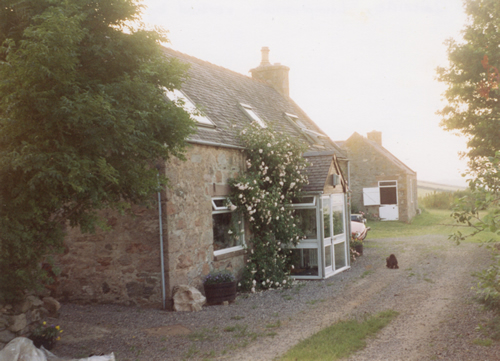
A recent photo at Gaitside, Lumphanan where the Lows lived
The family moved to a small croft at Coull when Rob was about five. Thatching was becoming less profitable, so they rented a farm at nearby Spawell to make a living.
From an early age, young Rob went to school in the winter and in the summer herded sheep at Wardle Farm, Lumphanan. He had a Border Collie called Fly who once killed a weasel and rolled in it (for the smell?) and whenever passing the spot for months later again rolled. At the time there was a little shop at the Cnoc, Tarland, where he sometimes went on messages.
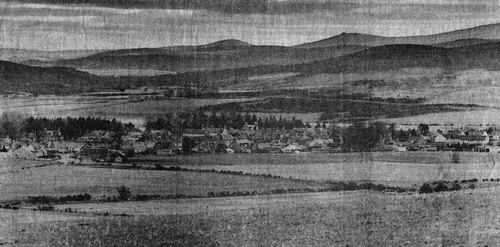
Tarland
When he was eleven, his father woke him one winter night as a terrific wind had sprung up and they had to rush out and tie everything down. When Rob got away from the house, the wind knocked him flat. It was a clear night and the entire district was visible, unlike the rain further south. That was the night of the famous Tay Bridge disaster.
He left school at 12 or 13 and signed on as a farm hand for six months at a farm called Broom Hill above Spawell (near Cnoc). It was a rough place with rats running around while they ate. The employer insisted that his workers put the horses in the stable whenever it rained, but the men had then to go out and cut thatch, without raincoats or oilskins.
Among other things Rob worked on a stone wall which was the boundary of Aboyne Castle (The Mains of Aboyne) on the Tarland Rd, north of Deeside Rd. It was known as The Brown Sugar Dyke as they mixed molasses with the lime mortar. Then he worked across the Dee for Glen Tanar Estate for an Englishman who said he would level the hills of Glen Tanar before he would pay another penny in income tax. The Englishman showed Rob how to top dress the cemetery by rubbing the soil through his hands rather than use a shovel. It was a twelve-hour day in summer. Rob walked to get there, probably not daily.
Rob's oldest sister Jessie had married John Philip and Rob also worked on the Philip farm where he had quartered in a redundant hen house and drove sheep, sleeping in the open carrying cold potatoes and oatcakes to eat. When he had to sleep out he wrapped himself in a plaid. His dog Fly was possibly still with him. He had to address his brother-in-law as Mr Philip and was not impressed.
Then to Glenfenzie, near Balmoral. Glenfenzie had once been populated enough to have caber-tossing in a field. Rob probably worked there as a shepherd. From Glenfenzie he walked home to see his family carrying two white hares all the way (over 15 miles each way).
Elizabeth Davidson
The Burn flows into River Gairn, which in turn runs into River Dee. Nearby were fourteen houses with chimneys. Most of the houses were stone and turf, thatched with heather, with earthen floors and no chimneys ("Black Houses"). The fields were stony, the farms were small, mostly hill pasture for sheep with a few cows, pigs and poultry. There were wild flowers in summer but the streams were frozen in winter.
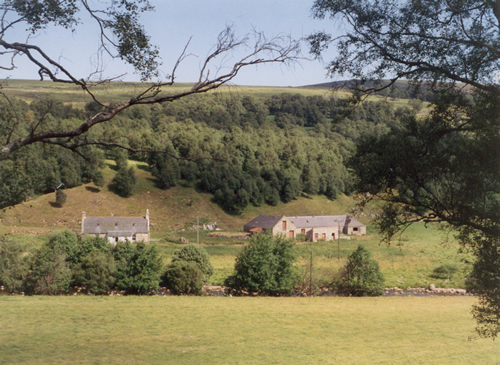
A recent photo at Balno, Glengairn where the Davidsons lived
The Davidsons lived at Balno, Glengairn, probably from 1700's. John Davidson (1752-1837) had a son Duncan born about 1770, who married Elizabeth Davidson (a relation?) about 1795 and had a son John born 1803, who married Margaret Gillanders and had a son Duncan in 1832. Duncan Davidson was a farm servant-labourer, later became an auctioneer in Glengairn, and a merchant and postman about 1900. In the Morven area, about two miles from Balno, lived McGregors, a family with a bad reputation, having been brought into the area in 1634 as mercenaries by the Laird "to tame the locals". Duncan met Margaret McGregor, born to Lewis McGregor and Anne (McPherson) 29-6-1829 at Aucherran, a few miles further north-east and married her at the Manse, Church of Scotland, Glenmuick on 5th December 1857.
Margaret and Duncan had five children, the first died at birth, the third in mid 1865. On 18th July 1864 they had a daughter Elizabeth. On Christmas Eve the next year Margaret died and Elizabeth was brought up by Jane Farquharson his father's sister who later left properties in Banchory to Elizabeth. Six years later Duncan married Isabella Fettes and had four more children two of whom also died as infants. Isabella smoked a pipe. By 1881 Elizabeth was a domestic servant at Rineaton, Glengairn. Ten years later she was working at the Manse.
By the age of 23 Rob was 6'3" and very broad. He had signed up to go to the Faulkland Islands as a shepherd, but joined the police force instead. He met Elizabeth Davidson, aged 27. Being a tall good-looking man no doubt he made an impression. On 5th June 1891, they married at Balno. He joined the Lanarkshire Police and went to Glasgow area, about 100 miles away. They had nine children Robert (Bobby), John (died young), James (died an infant), Alexander (Alex), Charles, Margaret (Meg), Gordon, Farquharson (Fachie) and Elizabeth (Lizzie), [mostly family, names]. All the older ones were born at police stations at Carfin and Muirhead, Cadder. When under the influence Rob could be abusive.
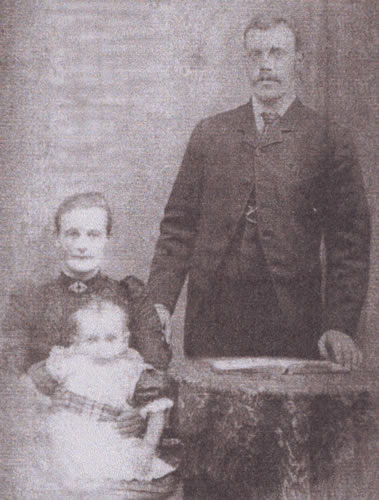
Rob, Elizabeth and Bobby 1893
One morning an inspector called to find the station closed and Rob in bed, as he had had a hard night with some rebellious colliers, now in the cells. There was a row and Rob threatened to fling the inspector in with the prisoners for breach of the peace. The inspector went away and soon Rob left the police force and became a school board officer (truant officer) from about 1900 in Coatbridge near Glasgow. The two youngest children were born at Auchenlonnan Cottage, Bargeddie, Coatbridge.
When Rob's father died in 1899 his brother Alex took over the rented farm at Spawell with his mother (who lived for another 22 years) and sister Sally. Other family members were nearby, Nelly near the Drummie and Wullie near Balmoral. Later Peter retired to the district.
Isabella Caven (Belle)
Elizabeth died at Bargeddie on 2nd May 1907, aged 43, leaving seven living children then aged from 15 to 18 months, six of them under the age of ten. Rob had to hire a housekeeper. Soon afterwards Rob met Isobella Caven (Belle) born 9th July 1872.
She was born at Low Porterbelly, Kirkgunzeon, Kirkcudbrightshire, a district with many remains of prehistoric settlements. Belle's parents were John Caven (farmer) and Jessie Mitchell, who had married at Newfield, Urr, Kirkcudbright on 7th January 1860.
Belle had gone into service and had become a qualified cook. She was now 35, Rob was 39. They met in Edinburgh at the Floral Clock in Princes Street gardens. On 8th November 1907 (six months after he was widowed) Rob married Belle in Edinburgh. At first they lived at Coatbridge east of Glasgow.
Belle looked after all the young children, her stepchildren accepting her as a mother.
During the next eight years they added five daughters, Isabella (Isa) born 29th July 1908, Catherine, Lilian (born at Perth died an infant in Glasgow), Mary and Robina (Bena). By then, 1916, they were living at Tillie Street, Glasgow. To all the children they were Ma and Da.
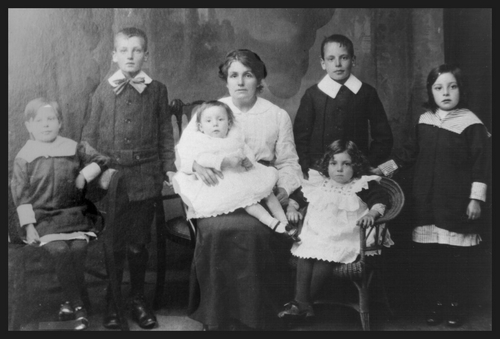
Elizabeth (9), Farquharson (11), Isabella (Belle) nursing Mary (1), Gordon (13), Isa (6) , Cathie on chair (3)
NEXT >>

 A recent photo at Gaitside, Lumphanan where the Lows lived
A recent photo at Gaitside, Lumphanan where the Lows lived  Tarland
Tarland A recent photo at Balno, Glengairn where the Davidsons lived
A recent photo at Balno, Glengairn where the Davidsons lived  Rob, Elizabeth and Bobby 1893
Rob, Elizabeth and Bobby 1893  Elizabeth (9), Farquharson (11), Isabella (Belle) nursing Mary (1), Gordon (13), Isa (6) , Cathie on chair (3)
Elizabeth (9), Farquharson (11), Isabella (Belle) nursing Mary (1), Gordon (13), Isa (6) , Cathie on chair (3)



